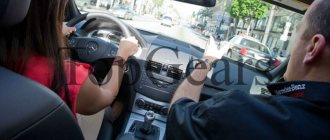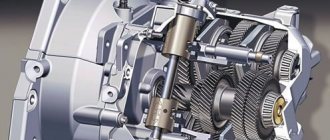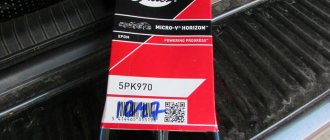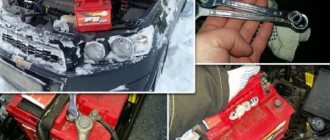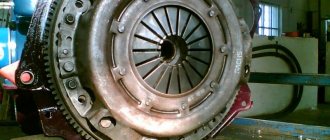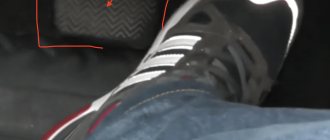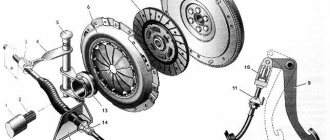It’s not difficult to learn how to drive off with a manual after an automatic. Novice drivers are often simply afraid to drive such a car, because it requires a special attitude.
In an automatic transmission, the entire process of switching the transmission is carried out by a computer, while in a manual transmission, control of the car falls entirely on the driver.
In this article we will try to help you master a car with a manual transmission. We'll tell you about ways to get moving with a manual transmission, step by step for dummies we'll analyze all the stages of starting to move a car with this gearbox. Let's consider the nuances associated with switching speeds, as well as other useful topics. But first, let's talk about the advantages and reasons for the popularity of this transmission.
Advantage of a car with manual transmission
A manual transmission has been and remains the most reliable vehicle control system. That is why all sports cars, including those for professional sports, are equipped with mechanics. The acceleration time for such a gearbox is significantly less than that of an automatic transmission and switching between speeds is faster.
The design features of a manual transmission are also reflected in the price. The mechanical design is simpler, so a car with such a gearbox costs much less than an automatic. And the difference between them can be from 10 to 30 percent of the cost of the entire car.
The savings are also reflected in performance characteristics:
- Manual transmission consumes significantly less fuel.
- Repairs are much cheaper. The same cannot be said about an automatic machine.
You can experience the feeling of complete unity with a car in motion, as if it is an extension of you, and you are part of it, only with mechanics.
Starting a car with an automatic transmission
An automatic transmission requires protection against incorrect starting, so such protection was immediately invented in tandem with the gearbox. If you don’t know how to properly start a car with an automatic transmission and this is your first time behind the wheel, you will struggle with the ignition.
Traditionally, starting an engine with an automatic transmission occurs as follows.
- The speed selector must be set to parking mode (P).
- Squeeze the brake pedal, do not release it, and start starting the engine.
- Insert the key into the lock and turn it until you hear a click. At this stage, the fuel pump starts and the indicators on the dashboard light up (read how to open a car door without a key).
- Turn the ignition key when the lights go out until the starter starts. Release the key and it will return to its original position.
- If the engine refuses to start, you can make a couple more attempts at intervals of half a minute.
- Move the selector to position D or R, taking into account the desired direction of travel, after the gearbox has warmed up. Start driving after releasing the brake pedal.
Warming up the engine after starting is a mandatory step, since it ensures normal operation of the engine lubrication system. This is explained by the fact that the oil mist necessary to lubricate the cylinders and pistons does not form immediately.
We also recommend that you additionally read our author’s article, in which he talks in detail about how to properly drive an automatic transmission.
Warm up the car while idling. In this case, the number of engine revolutions should be slightly higher than idle speed.
The role of the clutch in a car
Gears on a manual transmission are switched thanks to a special device - a clutch. It provides connection and disconnection between the transmission and the engine. The depressed clutch breaks the connection between them and allows you to switch the gear lever to the desired value.
Many of the difficulties in mastering a new method of driving manually are associated precisely with the operation of the clutch. Since the presence of a third pedal requires the driver to develop a new algorithm for moving away, accelerating and braking the car.
The first step in mastering a manual transmission is working with the clutch. First of all, you need to learn how to change gears without looking at the lever and learn their sequence. Remember the principle of switching and practice automatic actions on a stationary and unstarted car.
To do this, follow the following procedure:
- Depress the clutch pedal all the way (until the pedal is completely pushed to the floor).
- Place the gear lever in neutral and immediately shift to the desired speed.
- Slowly remove your foot from the clutch.
All actions are performed smoothly, accurately, without jerking.
But in order to learn how to move away, you need to fully master the mechanism of the clutch. The main rule for starting movement with a manual transmission is the simultaneous operation of the clutch pedal and accelerator. Below we will tell you how to get going with a manual transmission step by step for dummies.
The battery died in a car with a manual transmission
It is also worth knowing how to properly start a car with a dead battery. This problem occurs if the battery is weak and the weather is cold or damp. The first thing you can try is a push launch. The brakes must work properly. This method involves the use of male power as a tug, a road slope or a second car. If you have a carburetor, be sure to pump up the fuel by pressing the gas pedal 3-4 times.
To do everything right, follow these steps:
- Give the command to push the car after inserting the key into the lock and turning it.
- When the vehicle accelerates slightly, press the clutch pedal and engage second gear.
- Smoothly release the clutch pedal, after which you will feel the engine starting, accompanied by a slight jolt. Speed and driver calm are fundamental success factors in this case.
- Stop the car as soon as it starts, but do not turn off the engine, let it warm up for 15 - 20 minutes.
You may also be interested in an article by our expert, in which he tells what to do if the car does not start and the starter does not turn.
Additionally, we recommend reading the material, which tells you how to choose a booster to start the engine.
Another useful topic is making a winch from a starter with your own hands. Read about this in a detailed article by our specialist.
We also recommend reading the material, which describes in detail the principle of making a starting device for a car with your own hands.
It is allowed to repeat the above steps if nothing worked the first time. Before using this method, be sure to make sure that the manufacturer allows such measures. You can find out about this from the manual. If we are talking about a Chevrolet Aveo, for example, then such manipulations can seriously harm the engine.
The “lighting up” method is also relevant if there is no cable or strong men to push the car. To do this, you need a second car with a working battery and special wires with clamps used to transfer energy from a working battery to a dead one.
How to get moving with a manual transmission step by step for beginners
The clutch is mastered, and the gears are changed blindfolded, which means it’s time to move on. Well, then you just need to go, get moving. Learning to move away with a manual transmission is not difficult if you do it on a flat road without using the accelerator pedal. To do this, follow these steps to help you get used to controlling this type of transmission:
- With the car running, fully depress the clutch and move the lever to the first gear mark.
- We begin to slowly release our foot from the clutch pedal.
- When the car starts moving, lock your foot on the clutch in its current position.
- You can completely release the clutch pedal only after a couple of meters of movement of the car, when the car accelerates sufficiently.
It is worth noting that the engine may be too weak and will simply stall when trying to move off without gas. This occurs on many cars. Then not only beginners, even experienced drivers will have difficulties with this technique.
But in practice, we rarely start from a flat surface. Often, difficulties in getting started await us in the most unexpected places, for example:
- Stopping at a traffic light and then starting to drive often causes the engine to stall if the driver “throws” the clutch pedal.
- When going uphill, the car inevitably starts to roll back, which can lead to an accident.
Therefore, it is important to be able to move away manually up a hill or at an intersection (at a traffic light), without allowing the car to roll back or stall.
To avoid such problems, it is worth practicing and using the following techniques:
- Use the handbrake when starting.
- Apply clutch fixation (delay) using the brake pedal.
- Move away quickly, moving your foot from the brake pedal to the gas.
Let's look at the procedure for each of the methods to get moving on the mechanics in more detail.
Starting movement using the handbrake
Everyone, without exception, studies this method in driving school. To perform it we perform the following actions:
- Raise the handbrake all the way.
- Fully depress the clutch pedal.
- Move the lever to first speed.
- Gently start pressing the accelerator and fix your foot on the pedal when the tachometer shows a value of 1200-2000 rpm (depending on the slope of the hill).
- Next, we smoothly release the clutch and engage it until the car begins to “squat” and vibrations begin.
- Then we simply release the handbrake.
- As soon as the car starts moving, simultaneously release the clutch and add gas.
This starting algorithm is often used when you need to move smoothly up a hill after a long period of idle time with the handbrake. In other cases, other starting methods are often used.
Let's watch a video on how to drive uphill using the handbrake:
How to properly start with a manual transmission with gas?
The next starting method is only suitable for more experienced drivers or when you feel the car and can control it without looking at the instrument panel. And this can only be achieved through constant training.
With it, you can quickly move away at a traffic light or up a hill, without a significant rollback. The procedure should look something like this:
- The clutch is depressed, the right foot is on the brake.
- Next, release the brake pedal and quickly move your foot to the accelerator and raise the speed.
- At the same time, you must immediately begin to release the clutch pedal with your left foot and lock it at the moment when the clutch discs in your car have already begun to touch each other. Simply put, you need to catch the moment when your car starts to move away.
- Keep the engine speed at the set speed and continue to release the clutch as the vehicle speed increases.
Remember that you cannot accelerate too much, otherwise there is a risk of not only driving into the vehicle ahead, but also “burning” the clutch in your car. It is best to keep the tachometer at no more than 2000 engine rpm.
Be sure to watch another video on how to start uphill by catching the clutch and synchronously adding gas:
How to start a car on gas correctly
Cars equipped with gas cylinder equipment must be started only on gasoline. If you have a Euro-2 system installed, then switch the key to gasoline mode, and then start the engine. On Euro-4 equipment, the entire process is controlled electronically, so the engine will start on gasoline.
In order to start the car on gas , follow the following plan:
- in the case of Euro-2 equipment, move the key to o;
- pull out the choke and turn on the ignition;
- disengage the clutch and press the gas pedal when starting the engine, and when the engine starts working, be sure to hold your foot on the accelerator pedal for a few seconds so that the speed is at 1500-2000 rpm, this will prevent the engine from stalling;
- as practice shows, the engine can start on gas, but this method should be used only as a last resort;
- If you have Euro-4 equipment, then on the block with the warning lamp there is a button for forced fuel switching; when you turn on the ignition, hold down the button for 5 seconds, after which the engine will start on gas.
Shifting gears on mechanics
Without changing gears in a timely manner, it is impossible to learn how to drive a manual transmission correctly. The gear should be increased or decreased primarily depending on the engine speed, which is usually determined by ear. Let's look at this point using the example of overclocking.
The car has successfully moved off, picks up speed, the engine begins to “howl” strainedly, this means that it’s time to switch from first gear to the next. To do this you need:
- Depress the clutch.
- Carefully, without jerking, move the gearbox lever to the second speed mark.
- Next, we begin to gradually reduce the pressure on the clutch pedal, increasing pressure on the accelerator.
However, until the driver learns to determine the moment of gear shift by the engine operation, he will still have to monitor the tachometer and act depending on the following instructions for beginners:
- When the needle shows from 2500 to 3500 rpm, it's time to shift to a higher gear.
- If the tachometer shows less than 1500 rpm, then you should switch to a lower gear.
It should be noted that these recommendations apply to the case when the car is moderately loaded and moving on a straight road. If the car is overloaded or accelerates uphill, then you should switch much later than the indicated values, by about 500-1000 revolutions on the tachometer. This will help avoid multiple breakdowns in the future.
First and second gears will not be able to provide high speed; they only serve to accelerate the car more efficiently. For a comfortable and economical ride, speeds should be switched constantly. Changing to other gears is similar to the process described above.
By the way, you can also navigate by the speedometer, depending on the speed you turn on one or another speed. For most cars, the following step-by-step instructions will work:
- The speed is about 35 km/h - it’s time to engage third gear.
- Upon reaching 50 km/h, go to fourth.
- At fourth speed you can accelerate to 90 km/h, then you should switch to fifth.
Remember that you can only travel at speeds of 90 kilometers per hour or more outside populated areas, having fully mastered driving a car with a manual transmission.
Switching to lower speeds occurs in the same way as increasing them - using the clutch and moving the lever to the desired gear. The only difference is that in this case you need to release the gas a little, unless, of course, in your case, lowering the gear means reducing the speed of the car. But if, on the contrary, you need to quickly accelerate, then by lowering the gear, you need, on the contrary, to increase the engine speed, so to speak, to do a little “reversal” before releasing the clutch.
They brake with manuals, just like with automatics, without sudden pressure on the brake pedal. Usually, after braking, a gear shift to a lower gear is required. Stopping a car with a manual transmission is achieved by pressing the clutch and then braking, while the lever is moved to the neutral position.
How to drive a manual car correctly - the basics for everyone
Try to find a quiet place free from other cars. It will be better if the road or site is without slopes; this will make your first steps in mastering a manual transmission easier. In order to better hear the sound of the engine, you can lower the windows. This will help you get a better feel for the engine and gear shift timing. Adjust your rearview mirrors so that you can look into them comfortably.
Don't forget to buckle up!
Mechanical driving lessons begin with preparing the driver's seat. You need to adjust the side mirrors, rearview mirror, adjust the height of the driver's seat to suit your height, and fasten your seat belt. In the warm season, you can open the window: this way you will hear the engine running and quickly learn to feel the car. Next you need to familiarize yourself with the pedals.
Pedals
People who get into a manual car for the first time find it difficult to get used to the fact that they now also have to use their left foot. After all, in cars with an automatic transmission, only the right leg is used. The left foot will press the clutch pedal, and the right foot will be responsible for the brake and gas. On the left is the clutch pedal, in the middle is the brake, on the right is the gas pedal. The clutch is used to change gears. It is squeezed out with a quick press and released smoothly.
Details about what tiptronic is
The brake is needed to reduce speed and braking. It is pressed only with the right foot. The harder you press the brake, the faster the speed will decrease. The gas pedal regulates the supply of fuel mixture to the cylinders. The stronger the pressure, the higher the speed of the machine.
Shifting a manual transmission
To change gears correctly while driving, you need to fall into the desired speed range:
- first gear operating interval - from 0 to 20 km/h,
- second - from 20 to 40 km/h,
- third - from 40 to 60 km/h,
- fourth - from 60 to 90 km/h
- fifth - more than 90 km/h.
Mechanical gear shifting is carried out as follows. When the engine speed reaches 3000-4000, the second speed should be engaged. To do this, release the gas pedal and simultaneously depress the clutch pedal.
At first it may be very difficult, but over time it will happen automatically. While the car is coasting (the clutch is depressed all the way), the gear lever must be moved to the second speed position. After this, the clutch pedal is smoothly released and the gas pedal is pressed. It is worth emphasizing that each car has its own optimal gear shift moment. It directly depends on both the mechanical settings and the power of the power plant.
Mechanics can make the work of the brake system easier and improve the stability of a rear-wheel drive car on ice, allowing engine braking. To do this, you need to release the gas pedal and, after lowering the engine speed, squeeze the clutch all the way and quickly shift to a lower gear.
Algorithm for how to drive a manual car step by step
Now let’s look step by step at how to drive a manual car without stalling, after studying the theoretical material.
- We take the correct position behind the wheel of the car, check the position of the lever (it must be moved to neutral).
- Turn the key in the ignition and start the car engine.
- Next, press the brake with your right foot, depress the clutch pedal with your left foot and engage first gear.
- Then release the brake, place your right foot on the gas and at the same time smoothly release the clutch pedal.
- After the car moves slightly, we dose the traction with the accelerator pedal until the car begins to move confidently.
- After the car starts to move, completely remove your foot from the clutch pedal and continue to press the accelerator pedal to further increase the speed of the car.
- Having reached the required speed limit recommended for driving the car in first gear, release the gas, depress the clutch again and engage second gear. The clutch can now be released a little more sharply than when starting in first.
- If you select the right gear correctly, the box will shift without jolts or jerks.
How to drive a manual car correctly in traffic jams
What do you need to know to drive a manual manual correctly in traffic jams? We have already discussed that driving an automatic is much easier, although, as practice shows, an experienced driver drives a manual car with pleasure and does not experience the slightest discomfort. In addition, it is believed that manual transmissions are more reliable in operation. Let's look at some of the features of driving a manual car that every driver needs to know.
You need to learn how to change gears correctly and on time, while the clutch pedal must be depressed quickly and all the way to the floor. In addition, if you do not want to “burn out” the clutch very quickly, it is not recommended to keep the pedal fully depressed when parking in a traffic jam. You will also save the life of the release bearing.
The ideal option would be to have the clutch disengaged, the gearshift lever in neutral, and the car itself set to the parking brake. One of the main problems with frequent starts with a manual transmission is overheating of the clutch, which can cause its thermal deformation with the subsequent appearance of vibrations. In a traffic jam, where there is absolutely no need for a dynamic start, it is advisable to start with minimal addition of gas or without gas at all.
Find out what to do if the battery is dead
Let's sum it up
Independent practice, many hours of training or the help of more experienced car enthusiasts will immediately affect the results of a novice driver. To begin with, start learning how to start and drive correctly from vacant lots and race tracks, gradually moving to public roads. Master permanent routes on empty roads starting early in the morning. Gradually shift the time to the actual road conditions in which you will travel in the future.
Learn to relax, as manual driving does not tolerate fuss. A certain degree of comfort, which will have to be sacrificed when switching from an automatic to a manual, is rewarded with the pleasure of feeling full control over the car and invaluable driving experience.
That's all we wanted to say on this issue. In the article, we tried to cover in detail the topic of how to move away with a manual transmission step by step for dummies, and also touched upon other issues related to driving a car. We hope that this information was useful to you. We will be happy to answer your questions in the comments.
New articles
- Changing gears and starting to drive a manual transmission for beginners
- Driving on a race track: useful tips and tricks for novice drivers
The battery died in a car with automatic transmission
Often the battery in an automatic vehicle runs out in the winter. If in the case of mechanics you can get by with a “pusher,” the machine will not react to such actions. The only effective ways are to replace the battery with a new one, charge it, give the battery a warm bath, and also “light a cigarette.”
The last resort would be to transport the car to a warm box using a tow truck, but you should avoid moving it in tow. The brake boosters do not work in a car that is not running, so it is almost impossible to depress the pedal while driving.
Double squeeze and re-gas
This is a very old method of gear shifting that was performed on cars without synchronizers in the gearbox. Until now, only owners of old Volga cars and trucks use it . It meant manually equalizing the rotation speeds of the gearbox and engine shafts so that the gears were engaged without crunching or jamming. To do this, when accelerating, the clutch pedal was depressed, the lever was moved to the neutral position, the pedal was released, and then depressed again and the higher gear was engaged. When slowing down, while the lever was in the neutral position, it was necessary to add gas to increase the speed, and then suddenly turn on the lower speed.
Of course, now all cars have synchronizers installed that independently equalize frequencies, but skillful use of throttle control when overtaking will help you complete this dangerous maneuver faster.
Let's imagine a situation where you caught up with another car in 5th gear and intend to overtake it. The revs are low, which means overtaking will take a long time, which is undoubtedly unsafe, especially if you are not sure that there are no oncoming vehicles. Therefore, the fifth speed is turned off, the throttle is shifted, and the fourth speed is quickly turned on. Now the engine speed is much higher, which means the car can be accelerated better and you can overtake. At the end of overtaking, the speed will be sufficient to move with the same success in the fifth stage.
Why is this being done? To increase speed and extend the life of synchronizers. However, it is worth noting that with this method, fuel consumption increases noticeably.
What is a manual transmission?
To make it clearer, a manual transmission is a type of transmission that features manual gear shifting . In simple terms, the driver must change gears himself depending on road conditions. As a rule, manual transmissions use 4 or 5 speeds, as well as neutral and reverse gears. Before you start moving, you need to pay attention to the top of the lever to know where the desired speed is located.
Any manual transmission has a clutch, which is controlled by a third pedal. It is necessary to break the connection between the engine and the transmission, because it is in this state that the speed can be changed smoothly without danger to the gearbox. When turning on any stage, you must always press this pedal all the way.
Many drivers have the habit of “driving on the clutch”, thinking that there is nothing wrong with it . In fact, they lose control of the car, as it prevents them from slowing down or accelerating, and also has a detrimental effect on the release bearing, which quickly shortens its lifespan.
There are a number of nuances that you need to know.
- Firstly, this is the first speed - it is needed in order to get going, go through a difficult section of the road or climb a steep slope . All other gears are necessary for movement.
- Secondly, it is reverse speed, which helps us turn around . The operating range of this speed is very large and allows you to accelerate even faster than the first one. However, no mechanic can withstand prolonged work when moving in reverse, so you need to use it as little as possible.
Start of movement
This is perhaps the most difficult part for many novice drivers, as it requires a lot of practice . To start, you need to press the clutch pedal all the way and engage first gear. Now the right foot is above the gas pedal, and the left foot is on the clutch. To start moving, you need to smoothly release the clutch until the engine speed begins to drop slightly and maintain the nominal speed with the accelerator pedal. You can completely release the clutch only when the car starts moving.
A very common mistake is abrupt engagement of the clutch, which causes the engine to naturally stall as it encounters resistance from the gearbox . Of course, starting off smoothly the first time is quite problematic, but frequent practice will help you develop the necessary skills necessary to quickly start moving.

